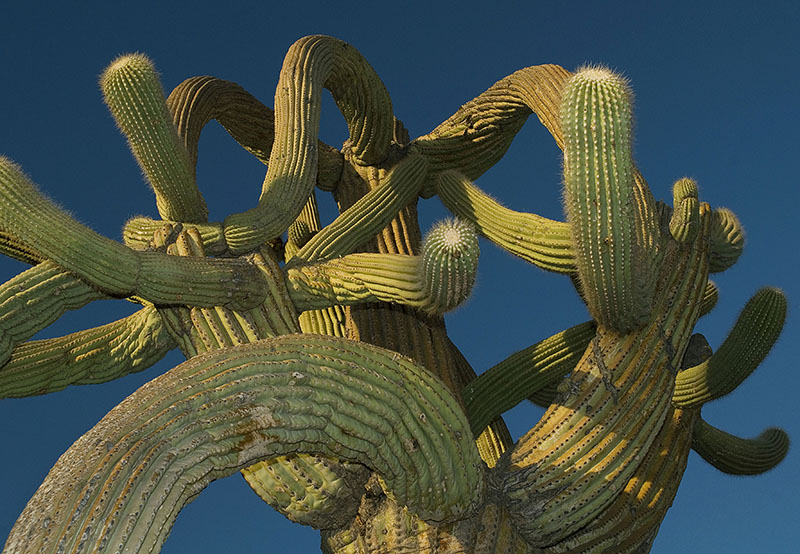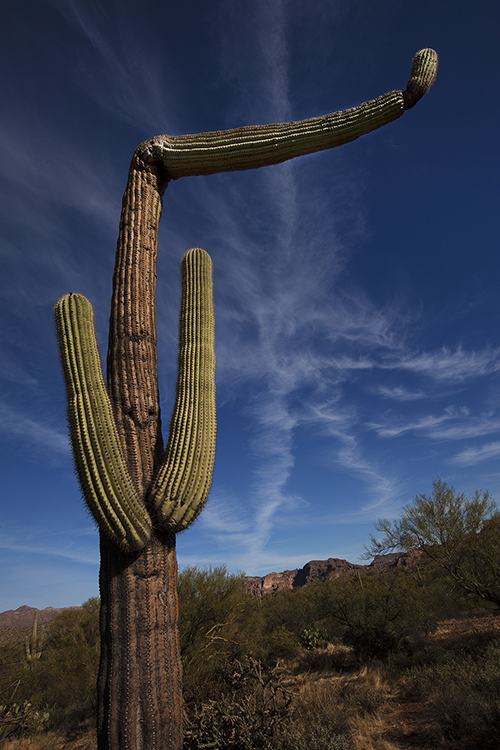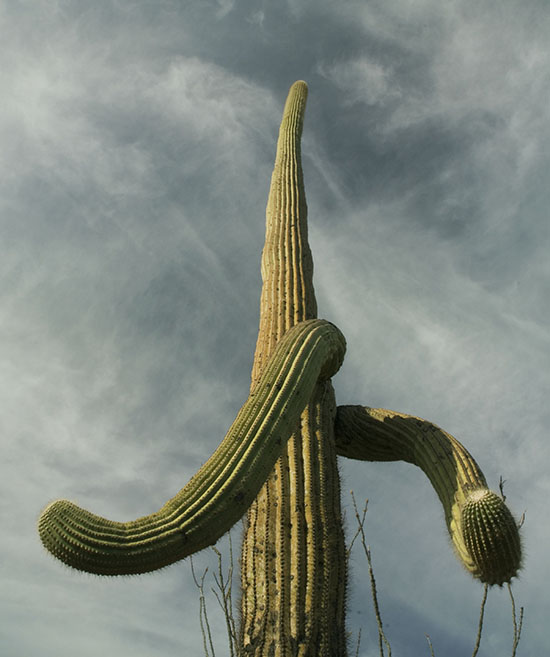Quirky Cacti

Writer Joseph J. Airdo
Photography by Dave Wilson
[dropcap]N[/dropcap]ature and landscape photographer Dave Wilson believes that many people who live in Arizona—himself included—often take saguaros for granted.
“People who come from other parts of the country must think that saguaros look like plants from another planet,” he says. “They are the most bizarre things. When people from the east coast see saguaros in person, they are astonished at just how tall they grow, how dense a cactus forest can be and how diverse their shapes can be.”
Those diverse shapes are the focus of this month’s photo essay. It is our hope that by showcasing some of the quirky cacti that can be seen around our state, Images Arizona will encourage you to rediscover our native plant species and be overtaken by their majestic and almost mythical appearance as if you were visiting Arizona for the very first time.
If anyone can truly attest to the fact that saguaros are like snowflakes in that no two are exactly alike, it would be Wilson—who makes it a point to hike off the beaten path to in an attempt to make his photos stand out in what has become an immensely crowded outdoor photography marketplace.



“I often end up heading into landscapes that most people would not consider all that glamorous,” Wilson says. “I go into a lot of places that are really plain. But I believe that the mark of a truly great photographer is the ability to wander into any landscape—even the most seemingly mundane places—and come away with something spectacular.”
That something spectacular may be a single tree, an unusual rock formation or—in many cases—a particularly silly looking saguaro. As illustrated by this month’s photo essay, saguaros seem to have a sense of humor unlike any other element of our southwestern landscape. Moreover, they are true icons of our state.
“You only see saguaros in Arizona,” Wilson says. “If you are driving from Phoenix or Tucson and you are going to California or New Mexico, you see millions of saguaros along the highway. But as soon as you cross the state line, they disappear. It is like saguaros know that they are citizens of the Grand Canyon state and they refuse to live anyplace else.”
For the Love of Nature
Dave Wilson considers nature and landscape photography to be synonymous with hiking.
“I was hiking long before I ever picked up a camera,” he says. “What motivates me the most is basic wanderlust; the opportunity to get off the beaten path and explore; that sense of discovery and adventure that comes with outdoor photography.”
Even on days that Wilson returns home from a hike without any great photos, he still feels greatly rewarded simply by having spent the day wandering around in nature.



“I find life in the city horribly confusing,” Wilson says. “I feel like I do not understand a thing about anything or anyone. But the wilderness makes perfect sense to me. I cannot explain why but it just does.”
Wilson’s process involves looking for what he calls “little, rectangular vignettes of perfect harmony in balance that exude a profound sense of wellbeing.” In fact, one art dealer who buys a lot of Wilson’s work describes his photographs as “healing art,” placing them in medical facilities throughout the Valley.
“I never saw my photos that way but I like it,” Wilson says. “They create a little sense of permanence of something beautiful.”
Unfortunately, Wilson worries that “something beautiful” is growing increasingly less permanent, though. He believes that global warming is the single greatest threat to our planet.
“When I am out doing photography, I have a sense that I am among the last generation to document the American southwest before it is ravaged by our changing climate,” Wilson explains. “In fact, I have this fear that future generations will look at my images and think that they have all been Photoshopped beyond reality.
“They will not believe that in southern Arizona, lush, tree-lined creeks and rivers used to flow among saguaros and prickly pear cactus. They will not believe that the mountains of northern Arizona had so much greenery. I feel I am currently photographing places in Arizona that, unfortunately, will look much less impressive to our children and grandchildren.”
About the Photographer
Dave Wilson first discovered his love of photography while embarking on nature hikes as a teenager.
“I would hike in the mountains around Tucson and I would always see wildlife like deer, javelina and bighorn sheep,” Wilson says. “I would come home and tell people about what I saw but they would either not believe me or think I was exaggerating.”
Wilson easily put those doubts to rest by bringing a camera along with him on his treks. For quite some time, his photography simply served as a record of his exciting sightings.



“Back then, I did not approach photography as an artist,” he explains. “I basically saw it as a form of hunting. Some people hunt with a gun. I hunted with a Canon. My goal was simply to get close enough to an animal for a killer shot.”
Wilson eventually obtained a career in public relations, serving as communications coordinator for the Downtown Mesa Association for 12 years. Commercial photography was an integral part of his job and, in turn, helped him hone skills that he later applied to nature and landscape photography.
“I have participated in all kinds of creative endeavors but the endeavor that I keep returning to more than any other is nature and landscape photography,” Wilson says. “That is probably because it is something that I can do completely alone. With outdoor photography, I can walk away from civilization altogether and work completely alone. And that is where I am most comfortable.”
Completely alone may be a bit of an exaggeration, though, as Wilson often brings with him his favorite hiking partner—his three-legged Australian cattle dog Jessee.
“I would rather hike with my dog than any person,” Wilson says. “But I carry 25 pounds of camera equipment plus my own water. I cannot carry enough water for my dog. So my choices of where I am going to hike are often limited to where I can take my dog—which means I gravitate toward places with natural water.
“I often choose to take photography near creeks, rivers and lakes just so I can bring her along. She has a ridiculously high impact on my outdoor photography.”

